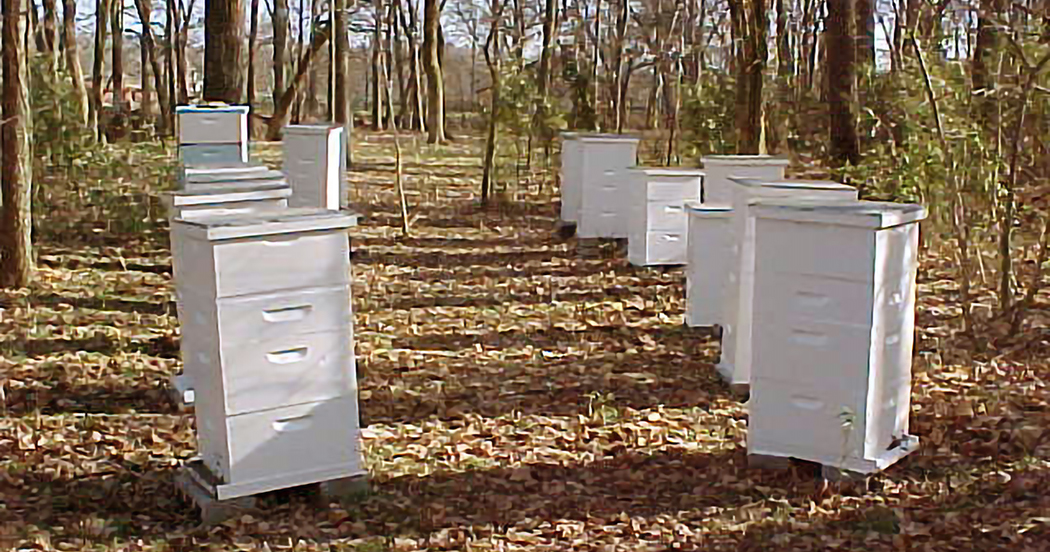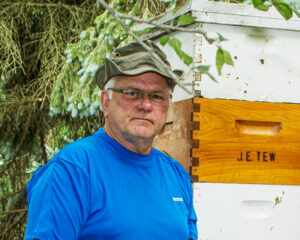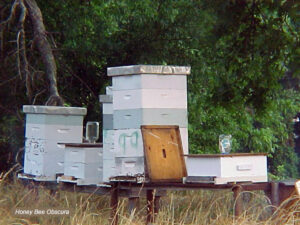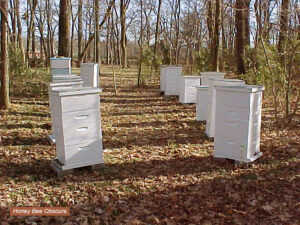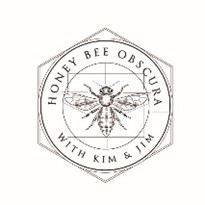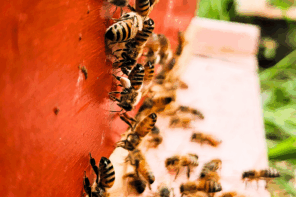Click Here if you listened. We’d love to know what you think. There is even a spot for feedback!
Read along below!
Equalizing Colony Populations
Trying to Make Weak Colonies Into Good Colonies
By: James E. Tew
Small hives visited and revisited
This past Summer, I occasionally had to equalize some colonies that I had started from packages. Even though the season is now wrong for equalizing colonies, try as I might, the subject of assisting, subsidizing, and managing small colonies keeps coming up in my mind. Why am I trying to prevent these extemporaneous thoughts? Because I have addressed them in previous articles to the point of belaboring the point. Yet, I am inspired yet again to pursue the topic but from a different perspective. Next Spring, I will try to do better.
Small colonies – they will always be with us
While most of my hives had respectable adult bee populations, some of my hives were not at full size. Some were, in fact, small. In my earlier article, In Defense of the Small Hive, I went to extremes to defend some of my hives being smallish. I still like smaller, albeit productive hives, but what if I have small hives mixed with stronger colonies in my yards?
Should accomplished beekeepers allow their colonies to express themselves? Some large. Some small. Some productive. Some not productive – but all in the same yard. Ideally, no, the smaller colony that is undersized size should be evaluated and addressed. An accomplished beekeeper would standardize his/her colonies to equalize the colonies so all are similarly sized. In general, more honey is obtained from two good colonies compared to the honey crop from one excellent colony and one small colony. Plus, if it does not grow, the small colony will go into Winter weak with all the inherent wintering survival problems. Finally, it is easier to anticipate equipment needs and management procedures if colonies are equalized. Colonies can be equalized any time they can be safely opened but warmer seasons are best.
Why are some colonies small?
Through many years of bee breeding and colony management, we now have colonies that are actually considerably larger than they would normally be in the wild state. In a contorted way, smaller colonies may actually be more normal than large colonies. Are all people the same height? Obviously not. Then why do we expect all beehives to naturally house populations of the same size? So, some colonies are genetically predetermined to be smaller than others. Depending again on the vagueness of genetics, smaller hives may be as productive as larger hives. True, larger hives would hypothetically gather more nectar, but simply by having more bee mouths to feed, they would also consume more honey. So, the answer to the question, “Do larger populations always produce more honey than small populations?” is begged but remains unanswered.
Is the small hive sick?
Evaluate the small hive. Does it appear to be suffering from the effects of a disease or pest? If yes, you can be helpful here by doctoring whatever problem is present. Again, colony genetics should be considered. The colony’s queen may have a genetic predisposition toward her offspring being affected by some disease or pest. Not much you can do about that other than requeen and address the problem.
But don’t overlook this point – the colony’s recovery from a disease or pest will be slow. Many times, the entire honey production from the present season will be lost. The colony will spend the current nectar production season convalescing. But after having a look, you find that there is no obvious disease or pest present, blame the queen – the beekeeper’s universal remedy.
Requeen, requeen, requeen
My current opinion is very nearly completely changed from what it was in years past. In many previous articles, I have defended marginal queens – hoping that things would improve. Additionally, newer beekeepers may be intimidated when attempting to supplant a failing queen with another. “Get over it” has recently become my present opinion. I and countless other authors have addressed the subject of queen failure and replacement. For instance, I once wrote an article entitled 101 Reasons a Queen Gets Replaced for this magazine. I routinely tell audiences that I am tender-hearted. I don’t like killing a queen for anything but the very best reasons. But, in a perfect bee management world, routine queen replacement should be the norm. “Don’t waste either your time or the colony’s time with a marginal or failing queen.” So, in my imaginary yard, I have a strong colony positioned by a smaller colony – a smaller colony that is apparently disease-free. What to do?
Dramatically equalizing two colonies – one small, one large
Very importantly, be patient. A profound equalization can take several trips before the task is completed. If you requeen, transfer brood and adult bees and exchange hive positions at one time, so much change will be going on at once that too much confusion may result. Be patient.
I suspect the queen in the smaller hive should be retired. In fact, while you are buying queens, should you also proceed with requeening the larger hive? Probably. I am much more comfortable now with annual requeening than I was just a few years ago when the general recommendation was to requeen every two years. You will need to give yourself and your queen producer time to get the replacement queens to you. It will probably take a couple of weeks, during the warm season, to get the replacement queens. It’s true. While you wait, the season is passing, but little can be done about that. Once you have received the new queens, proceed with the requeening process.
In a perfect bee world, the nectar flow is still ongoing. Any hive manipulation is simpler during a nectar flow. However, if there is no flow, expect more colony defensiveness and watch for robbing.
Your options
The common procedures for colony equalization are: (1) moving capped and/or uncapped brood, (2) moving adult bees, (3) transferring frames of honey, and (4) exchanging colony positions. Numbers 1 – 4 are all imprecise and will require you to use your best guesses.
Moving brood
Everything is a variable – the time of the year, nectar flow on or off, how many hives are in the yard, your ability, how dry it is, how many bees are flying – everything is a variable. Use your beekeeping experience. If you must absolutely guess, then guess conservatively. There’s no other way to gain experience.
Open brood. Early in the season, you would not want to overload the smaller colony with uncapped brood. Such brood will need feeding and incubating. So, something like eight frames of open brood would overwhelm two frames of adult bees in a cool climate in early May. In a warmer climate, you and your colony could get away with a heavier open brood shift – but still not eight frames. More like two – three frames. Remember – be patient.
Capped brood. Capped brood is more forgiving. It has already been fully fed and much of the incubation requirement is past. In May, most cool nights have passed, but if you give too many frames of capped (or open for that matter) brood and the colony pulls back into a cluster, brood may die from exposure to cool temperatures. Again, I’ll bet that something like one – three frames will be about right.
Adult bees. Adult bees can be shaken from brood frames into the smaller hive. Watch for several things. Don’t accidentally shake the queen from the stronger colony into the smaller unit. Since you may damage developing larvae, don’t harshly bounce the brood frames on other woodenware. Just give the frame a good shake just above the smaller colony. Realize too that many of the shaken adult bees will soon return to the parent colony so shake more than is necessary. Finally, if you are concerned about the safety of the queen in the smaller hive, recage her for a day or so until things have settled back down.
Strictly for the sake of discussion
Due to the number of variables, I will make up a hypothetical situation between a large hive and a small one, two hives that I intend to equalize. The larger hive has a queen of unknown age, ten frames of brood, seventeen frames of adult bees and ten frames of capped honey. My make-believe smaller hive has a queen that is producing a spotty pattern, two frames of brood – some capped and some uncapped, three frames of honey and seven frames of adult bees. It is about 30% of the size of the larger hive. The brood nest area of both hives is two deeps.
First, in the smaller hive, I replace the queen with a new queen and wait until I see eggs. That’s my cue that the new queen has been accepted by the bees in the smaller hive. This may take about two weeks tops. Due to the trauma that I am about to cause the larger hive, I decide NOT to replace the queen in the larger unit at this time, but I make a mental note that she should be replaced yet this season. I smoke both colonies meaningfully and open both units. I look at both hives for a perspective of how each is doing. It is late May, but I still have a nectar flow underway. It’s just after lunch on a nice day and bees are freely flying. I remove the (imaginary) two supers from the parent colony and set them aside. I pull the center three frames (yes, I should have taken the frames from the side first, but I am a beekeeper who is in a hurry.) and look for the queen but I do not see her. In order not to have the queen jump frames, as I “look” these three frames, I temporarily set them in an empty deep that I brought along for this purpose. My smaller hive is not really using the top deep so for the present, I set it to one side. It is essentially empty except for about 500 bees strolling about looking bored. The three frames I pulled out of the larger colony were all capped brood. I take two of them and put them beside the brood nest of the smaller colony but I leave one space open in the center. I check for my new queen on the three empty frames I remove from the smaller hive. She’s not there, but I commonly see eggs in other brood frames so I feel pretty good about her future. Since these frames from the small hive are essentially empty, I set them aside. I return to the larger colony and search for a frame of uncapped brood which I reposition pretty much in the center of the smaller hive. So far, in the smaller hive, I have replaced the queen and given the colony two frames of capped brood and a single frame of uncapped brood in addition to the original two spotty frames of brood. I consolidate the brood nest in the center of both hives and put the three empty frames from the smaller hive into the larger hive at the edge. I have checked the smaller hive for diseases like American foulbrood and found none. A quick glance at the frames I was transferring to the smaller hive were also disease-free. I considered moving some frames of honey but a nectar flow is on so I don’t sense that the smaller colony will need it.
I brought along two ratchet straps and I reassemble both hives (minus the honey supers for the present) and ratchet-strap them individually. I grunt and groan – using the straps as handles – and switch positions of the hives so the larger hive is now where the smaller hive was sitting and vice versa. Bees are flying everywhere. Since I have a nectar flow underway and the bees are not particularly aggressive, I elect not to recage my new queen. I have been occasionally smoking both hives and have seen no indications of bees fighting. For precautions, I put entrance reducers in both hives and now, after the moving is finished, I put the two honey supers back on the larger hive and the empty deep back on the smaller hive and reassemble the hives. In this new position, the smaller hive has been given a new queen, three frames of brood, and the field force from the larger hive. The larger hive got nothing out of the deal but three empty frames and a temporarily reduced foraging population.
A week later I return on yet another nice day when bees are flying. I look at both hives and remove the entrance reducers. Both colonies are queen-right, but as I expected, the larger hive is still somewhat larger. The nectar flow is waning. I remove three frames of either capped or uncapped brood – checking all frames for the queens – and once again bump up the brood population of the smaller hive by giving it three frames of brood. As before, the larger hive gets three empty frames. This time, I don’t reposition the hives nor do I transfer adult bees. By now, my second queen has arrived and I proceed to requeen the larger hive. I remember to be patient. While I and my two colonies have made good progress and both are now similar in size, they are still not twins. I decide to wait until after the Summer dearth to see how well the smaller unit responds. I can check my second requeening project is about two weeks.
I got a bit of a honey crop from both hives, but at this point, I am not certain that it is surplus honey. If all does not go well during the Fall flow, I will need to leave them that honey for wintering purposes. I have essentially spent much of the Spring and Summer equalizing these two colonies.
From start to finish, this entire episode has been fictional, but I hope it gives you an idea of the decision-making process and the hurdles to be faced by the two colonies and you.
Package bees and small swarms – a variation
It’s not a big jump to envision a package of bees or a small swarm being the smaller hive in my fictional episode above. A package colony can be subsidized from a larger hive in exactly the same way – except easier – the queen does not need replacing. Nearly on a different subject, if you install multiple packages at the same time, you can expect some package colonies to acquire more bees that others as disoriented bees fly around looking for a home. It is not uncommon to return to the yard a few days later and equalize package strength among the new colonies.
Swarms can be equalized in the same manner as described above. The swarm queen will be suspect and should be replaced as soon as the colony has stabilized. Normally, colonies initiated from swarms develop quickly, but if you feel it is necessary, a swarm colony can be given help also.
Minimally equalizing two colonies
Once the colonies are similar and queens are comparable, simple brood frame transfers are normally enough to approximate equalization. However, rarely (never?) will all the colonies in your yard be clones of each other. As I said earlier, everything varies. Something as mundane as where a particular hive is positioned is important. It is commonly known in beekeeping that colonies on the ends of rows pick up forager bees from colonies in the center of the row. Who knows why some colonies thrive while others languish when all are being exposed to the same resources?
The cold truth
I rarely go to much effort to equalize colonies that are mostly similar. Put yourself in the real yard. In the real bee world, there are not two colonies but say, for example, there are twenty. Which colonies becomes the standard? Do you equalize hive #3 with hive #12 or #7 with #9? A more traditional approach would be to mentally evaluate colonies, determine the disease and queen status of small colonies, and make general changes in brood sharing. It’s always relative.
Additionally, all this brood sharing recommendation assumes that you, the beekeeper, are proficient at American foulbrood recognition. A topic for a future article, I must say that beekeepers are the primary way diseases are spread. So after having written nearly 2800 words, I now tell you that doing the right thing – equalizing – can sometimes be the wrong thing. Always, do no harm.
An addendum – as I reread this piece before submitting it, I had the clear thought that equalizing colonies approaches diminishing returns. Don’t hit the better colony so hard that you end with two marginal colonies. In a future article, I may address working – only – with marginal colonies to make them stronger and don’t diminish the productive colonies. Equalizing colonies should aid the weaker colony without serious loss to the better colony. “If in doubt, don’t.”
Dr. James E. Tew
Emeritus Faculty, Entomology
The Ohio State University
tewbee2@gmail.com
Host, Honey Bee
Obscura Podcast
www.honeybeeobscura.com







